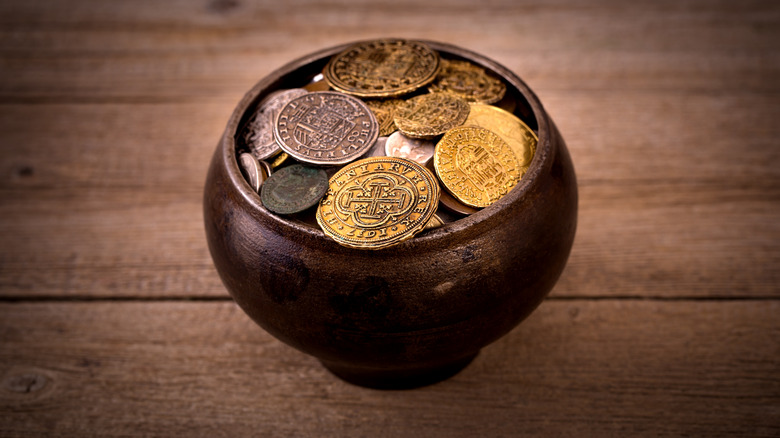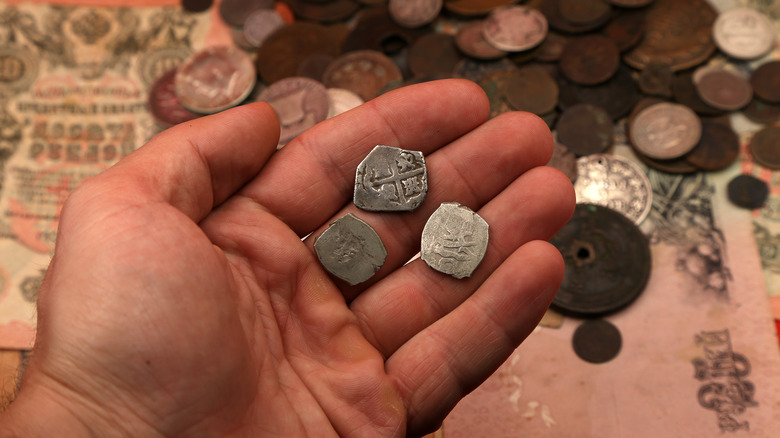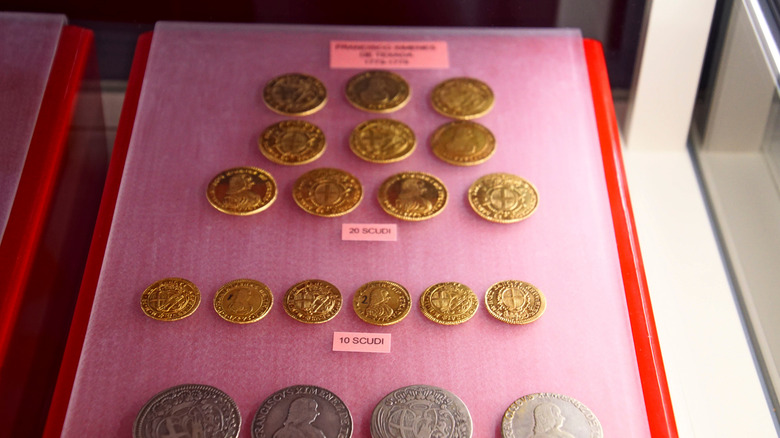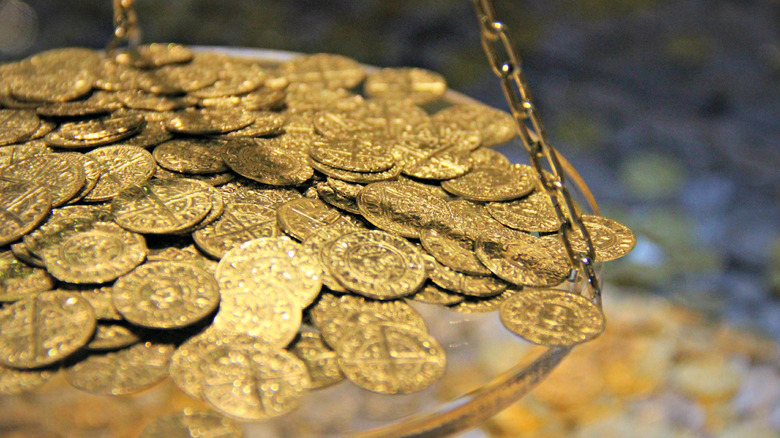The Story About The Time When Europe Ran Out Of Coins
The Great Bullion Famine that lasted from 1457 to 1464 wasn't the only time Europe experienced a shortage of coins. But in addition to being one of the worst shortages of precious metals that Europe ever experienced, the coin famine set the stage for Europe's exploitation and colonization of the American and African continents.
The European desire for gold was so great that in his diary of his first voyage, Christopher Columbus mentions gold 65 times, per "The Encyclopedia of Money." And the influx of gold from the West African coast was so influential in England that when the Royal Mint made a new gold coin in 1663, people referred to it as the "guinea," called so after the name given to the West African coast by the Portuguese, according to "How Europe Underdeveloped Africa." The coins also bore the Royal African Company's logo, the same company which was responsible for transporting hundreds of thousands of enslaved people across the Atlantic.
The European economy relished the influx of gold and silver and before long, the gold trade became inseparable from the trade of enslaved people. Meanwhile, according to Stephan Talty's "Empire of Blue Water: Captain Morgan's Great Pirate Army, the Epic Battle for the Americas, and the Catastrophe That Ended the Outlaws' Bloody Reign," it's estimated that 180 tons of gold and 16,000 tons of silver came in through the port of Seville alone between 1500 and 1650. But what exactly was this "coin famine"?
The shortage of precious metals
Several factors contributed to the shortage of precious metals in Europe in the 15th century. According to "The Encyclopedia of Money" by Larry Allen, silver mines in what is now Germany, Austria, the Czech Republic, and Slovakia were depleted by the 15th century. Other areas in Europe saw diminished silver production because the mass deaths caused by the Black Plague meant there were fewer people who could work.
A trade deficit also reportedly existed between Europe and Asia. While products from China and India were highly valued and sought after in Europe, woolens from England weren't valued as highly in Asia. Meanwhile, silver was a valued commodity and "European precious metals sent to the East in payment for goods never returned in payment for exported European goods," writes Allen. Another factor that's suggested to have influenced the Great Bullion Famine was the hoarding of plates, cups, and jewelry made of precious metals within Europe.
According to "The Power of Gold: The History of an Obsession" by Peter L. Bernstein, the output of the mint in the Tower of London fell from an average of almost $7,000 in gold coins in the 1460s to less than $3,000 by 1485. It then "virtually came to a halt over the next 10 years."
This wasn't the first bullion famine that Europe experienced. The first bullion famine lasted from 1208/14 to 1250, and the second lasted from 1392 to 1412/25, according to "Mining, Metallurgy, and Minting in the Middle Ages."
The Great Bullion Famine
Due to the shortage of precious metals, there was a lack of coins across Europe. As a result, many communities had to either use mixed payments of coins as well as goods, or simply barter. In some areas, "rents were once again being paid in produce," Diana Wood writes in "Medieval Economic Thought." In the cloth industry in England, workers were paid mainly in goods until an act of Edward IV in 1464 mandated that workers were to be paid "lawful money for all their lawful wages."
There's also debate about whether or not the bullion famine led to an expansion or a contraction of the use of credit. According to "The Non-Use of Money in the Middle Ages" by Adrian R. Bell, Chris Brooks, and Tony K. Moore, while some historians and economists have suggested that the use of credit could've led to an increase of economic activity, others contend that credit is only valid if it has a backing, and without the backing of coinage, "if there is no such expectation, there can be no credit." In "Credit and Trade in Later Medieval England, 1353-1532," Richard Goddard notes that the contractions in credit in London between 1350 and 1440 correlated with the decrease of currency in circulation.
Exploitation of Africa and the Americas
From the middle of the 15th century into the 17th century, Europeans extracted precious metals from the West African coast as well as Central and South America. In 1441, Portuguese sailors traded for gold on the West African coast for the first time. The following year, according to PBS, Portuguese sailors returned from the coast with more gold dust as well as 10 enslaved people from sub-Saharan Africa.
According to "The Dutch Century," by Carl Douglass, the Portuguese monopolized the gold trade on the West African coast and were the first Europeans to mine for gold there. And countless enslaved people were killed during mining collapses. Some communities, like the Akan kingdom, traded gold for European weaponry, according to "Journal des Africanistes." However, Walter Rodney notes in "How Europe Underdeveloped Africa" that much of what was exported out of Europe were goods "of the worst quality." And because there wasn't much gold in Africa accessible to Europeans at the time, "the principal export was human beings."
The discovery of gold and silver in the Americas also fueled the trade of enslaved people. Europeans initially just stole the gold possessions of indigenous populations, and then went on to force Native communities to mine for gold, which was taken back to Europe, Glyn Davies writes in "History of Money." After disease and overwork decimated the population, enslaved Africans were brought across the Atlantic to continue the work of mining for precious metals.



